BSc Business Management: Financial Performance Analysis and Report
VerifiedAdded on 2023/06/05
|12
|2780
|457
Report
AI Summary
This report, submitted as part of a BSc (Hons) in Business Management, delves into the core concepts of financial management, emphasizing its significance in business operations. The report provides a comprehensive definition and discussion of financial management, including its role in maximizing profit and ensuring sustainability, and covers the three main financial decisions: investment, financing, and dividend. The report then analyzes key financial statements, including the balance sheet, income statement, and cash flow statement, and explains the application of financial ratios to assess a company's financial health, including liquidity, efficiency, and profitability. The analysis includes using a provided template, creating an income statement and balance sheet in Excel, and applying ratio analysis based on a case study to evaluate the company's performance. The report concludes by discussing strategies the business could implement to enhance its financial performance, drawing on the case study examples to illustrate practical applications of the concepts discussed.
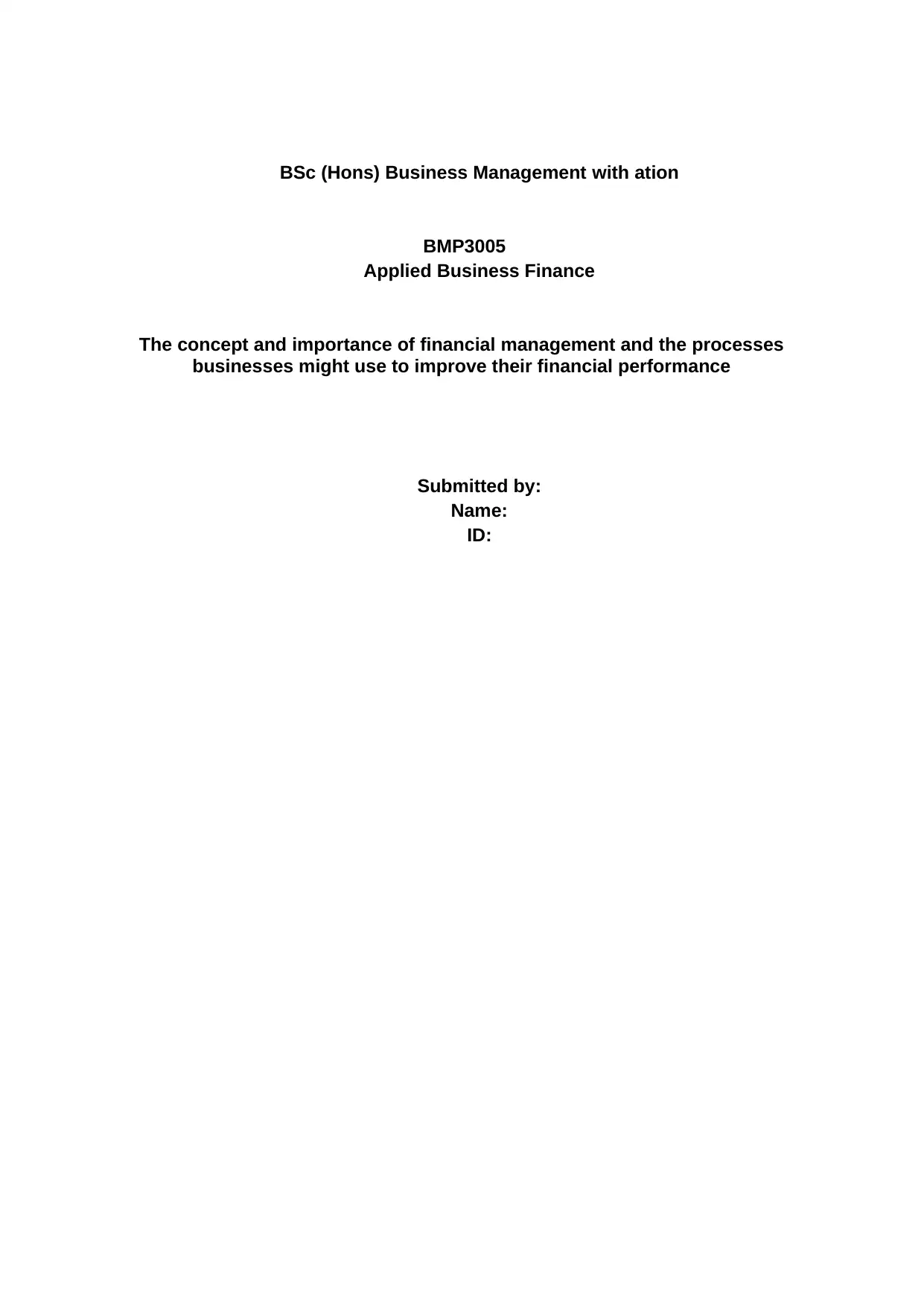
BSc (Hons) Business Management with ation
BMP3005
Applied Business Finance
The concept and importance of financial management and the processes
businesses might use to improve their financial performance
Submitted by:
Name:
ID:
BMP3005
Applied Business Finance
The concept and importance of financial management and the processes
businesses might use to improve their financial performance
Submitted by:
Name:
ID:
Paraphrase This Document
Need a fresh take? Get an instant paraphrase of this document with our AI Paraphraser

Contents
Introduction p
Section 1: Definition and discussion of the concept and importance of financial
management p
Section 2: Description and discussion of the main financial statements and explain
the use of ratios in financial management
p
Section 3: Using the template provided p-p
i. Completing the Information on the ‘Business Review Template (Ensure
that you display your calculations for this detail)
p
ii. Using Excel producing an Income Statement for the Sample Organisation
(see Case Study). This should be included within your appendices
p
iii. Using Excel completing the Balance Sheet p
iv. Using the Case study information describing the profitability, liquidity and
efficiency of the company based on the results of ratio analysis
p
Section 4: Using examples from the case study describing and discussing the
processes this business might use to improve their financial performance
p
Conclusion p
References
Appendix p
Introduction p
Section 1: Definition and discussion of the concept and importance of financial
management p
Section 2: Description and discussion of the main financial statements and explain
the use of ratios in financial management
p
Section 3: Using the template provided p-p
i. Completing the Information on the ‘Business Review Template (Ensure
that you display your calculations for this detail)
p
ii. Using Excel producing an Income Statement for the Sample Organisation
(see Case Study). This should be included within your appendices
p
iii. Using Excel completing the Balance Sheet p
iv. Using the Case study information describing the profitability, liquidity and
efficiency of the company based on the results of ratio analysis
p
Section 4: Using examples from the case study describing and discussing the
processes this business might use to improve their financial performance
p
Conclusion p
References
Appendix p
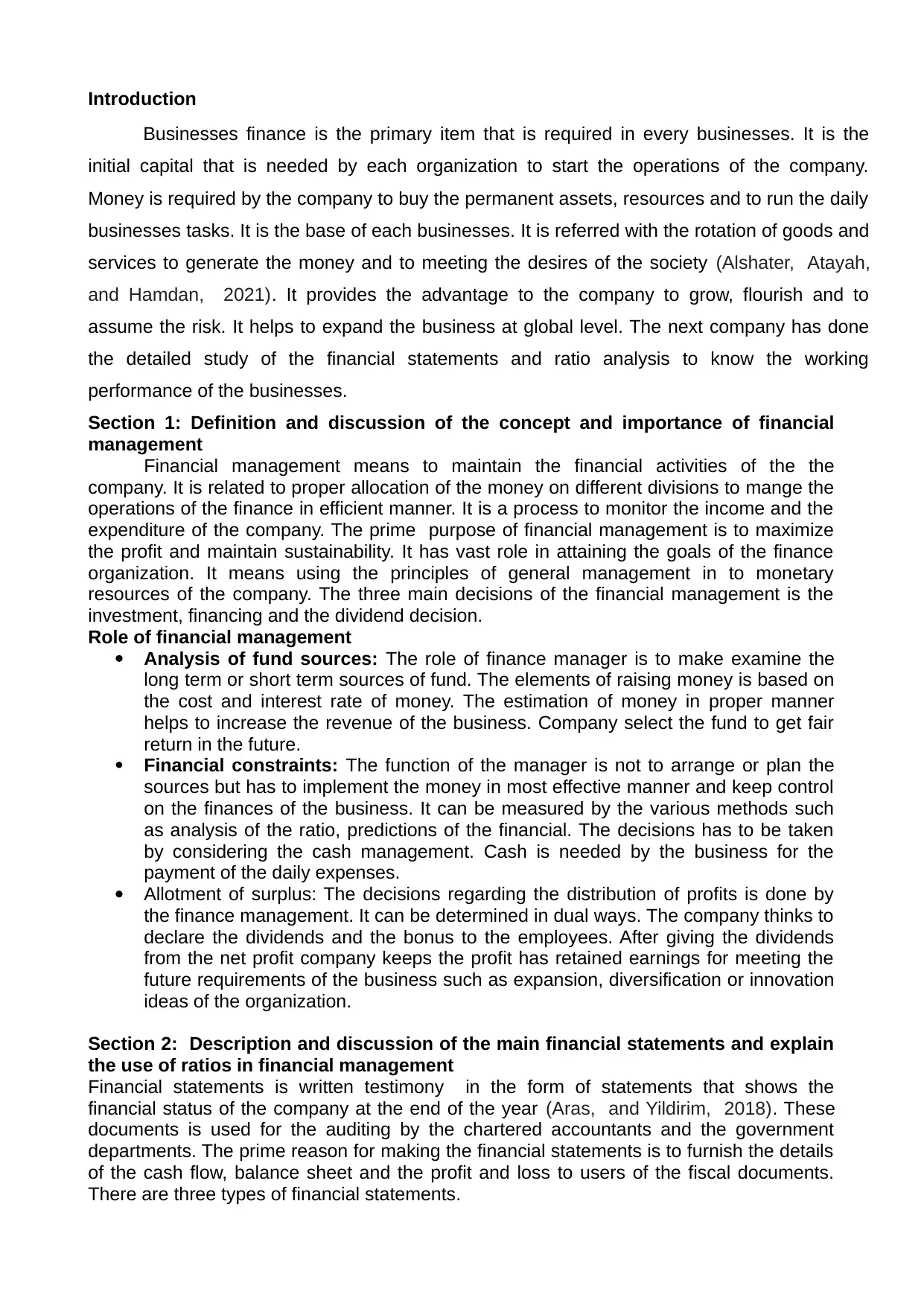
Introduction
Businesses finance is the primary item that is required in every businesses. It is the
initial capital that is needed by each organization to start the operations of the company.
Money is required by the company to buy the permanent assets, resources and to run the daily
businesses tasks. It is the base of each businesses. It is referred with the rotation of goods and
services to generate the money and to meeting the desires of the society (Alshater, Atayah,
and Hamdan, 2021). It provides the advantage to the company to grow, flourish and to
assume the risk. It helps to expand the business at global level. The next company has done
the detailed study of the financial statements and ratio analysis to know the working
performance of the businesses.
Section 1: Definition and discussion of the concept and importance of financial
management
Financial management means to maintain the financial activities of the the
company. It is related to proper allocation of the money on different divisions to mange the
operations of the finance in efficient manner. It is a process to monitor the income and the
expenditure of the company. The prime purpose of financial management is to maximize
the profit and maintain sustainability. It has vast role in attaining the goals of the finance
organization. It means using the principles of general management in to monetary
resources of the company. The three main decisions of the financial management is the
investment, financing and the dividend decision.
Role of financial management
Analysis of fund sources: The role of finance manager is to make examine the
long term or short term sources of fund. The elements of raising money is based on
the cost and interest rate of money. The estimation of money in proper manner
helps to increase the revenue of the business. Company select the fund to get fair
return in the future.
Financial constraints: The function of the manager is not to arrange or plan the
sources but has to implement the money in most effective manner and keep control
on the finances of the business. It can be measured by the various methods such
as analysis of the ratio, predictions of the financial. The decisions has to be taken
by considering the cash management. Cash is needed by the business for the
payment of the daily expenses.
Allotment of surplus: The decisions regarding the distribution of profits is done by
the finance management. It can be determined in dual ways. The company thinks to
declare the dividends and the bonus to the employees. After giving the dividends
from the net profit company keeps the profit has retained earnings for meeting the
future requirements of the business such as expansion, diversification or innovation
ideas of the organization.
Section 2: Description and discussion of the main financial statements and explain
the use of ratios in financial management
Financial statements is written testimony in the form of statements that shows the
financial status of the company at the end of the year (Aras, and Yildirim, 2018). These
documents is used for the auditing by the chartered accountants and the government
departments. The prime reason for making the financial statements is to furnish the details
of the cash flow, balance sheet and the profit and loss to users of the fiscal documents.
There are three types of financial statements.
Businesses finance is the primary item that is required in every businesses. It is the
initial capital that is needed by each organization to start the operations of the company.
Money is required by the company to buy the permanent assets, resources and to run the daily
businesses tasks. It is the base of each businesses. It is referred with the rotation of goods and
services to generate the money and to meeting the desires of the society (Alshater, Atayah,
and Hamdan, 2021). It provides the advantage to the company to grow, flourish and to
assume the risk. It helps to expand the business at global level. The next company has done
the detailed study of the financial statements and ratio analysis to know the working
performance of the businesses.
Section 1: Definition and discussion of the concept and importance of financial
management
Financial management means to maintain the financial activities of the the
company. It is related to proper allocation of the money on different divisions to mange the
operations of the finance in efficient manner. It is a process to monitor the income and the
expenditure of the company. The prime purpose of financial management is to maximize
the profit and maintain sustainability. It has vast role in attaining the goals of the finance
organization. It means using the principles of general management in to monetary
resources of the company. The three main decisions of the financial management is the
investment, financing and the dividend decision.
Role of financial management
Analysis of fund sources: The role of finance manager is to make examine the
long term or short term sources of fund. The elements of raising money is based on
the cost and interest rate of money. The estimation of money in proper manner
helps to increase the revenue of the business. Company select the fund to get fair
return in the future.
Financial constraints: The function of the manager is not to arrange or plan the
sources but has to implement the money in most effective manner and keep control
on the finances of the business. It can be measured by the various methods such
as analysis of the ratio, predictions of the financial. The decisions has to be taken
by considering the cash management. Cash is needed by the business for the
payment of the daily expenses.
Allotment of surplus: The decisions regarding the distribution of profits is done by
the finance management. It can be determined in dual ways. The company thinks to
declare the dividends and the bonus to the employees. After giving the dividends
from the net profit company keeps the profit has retained earnings for meeting the
future requirements of the business such as expansion, diversification or innovation
ideas of the organization.
Section 2: Description and discussion of the main financial statements and explain
the use of ratios in financial management
Financial statements is written testimony in the form of statements that shows the
financial status of the company at the end of the year (Aras, and Yildirim, 2018). These
documents is used for the auditing by the chartered accountants and the government
departments. The prime reason for making the financial statements is to furnish the details
of the cash flow, balance sheet and the profit and loss to users of the fiscal documents.
There are three types of financial statements.
⊘ This is a preview!⊘
Do you want full access?
Subscribe today to unlock all pages.

Trusted by 1+ million students worldwide
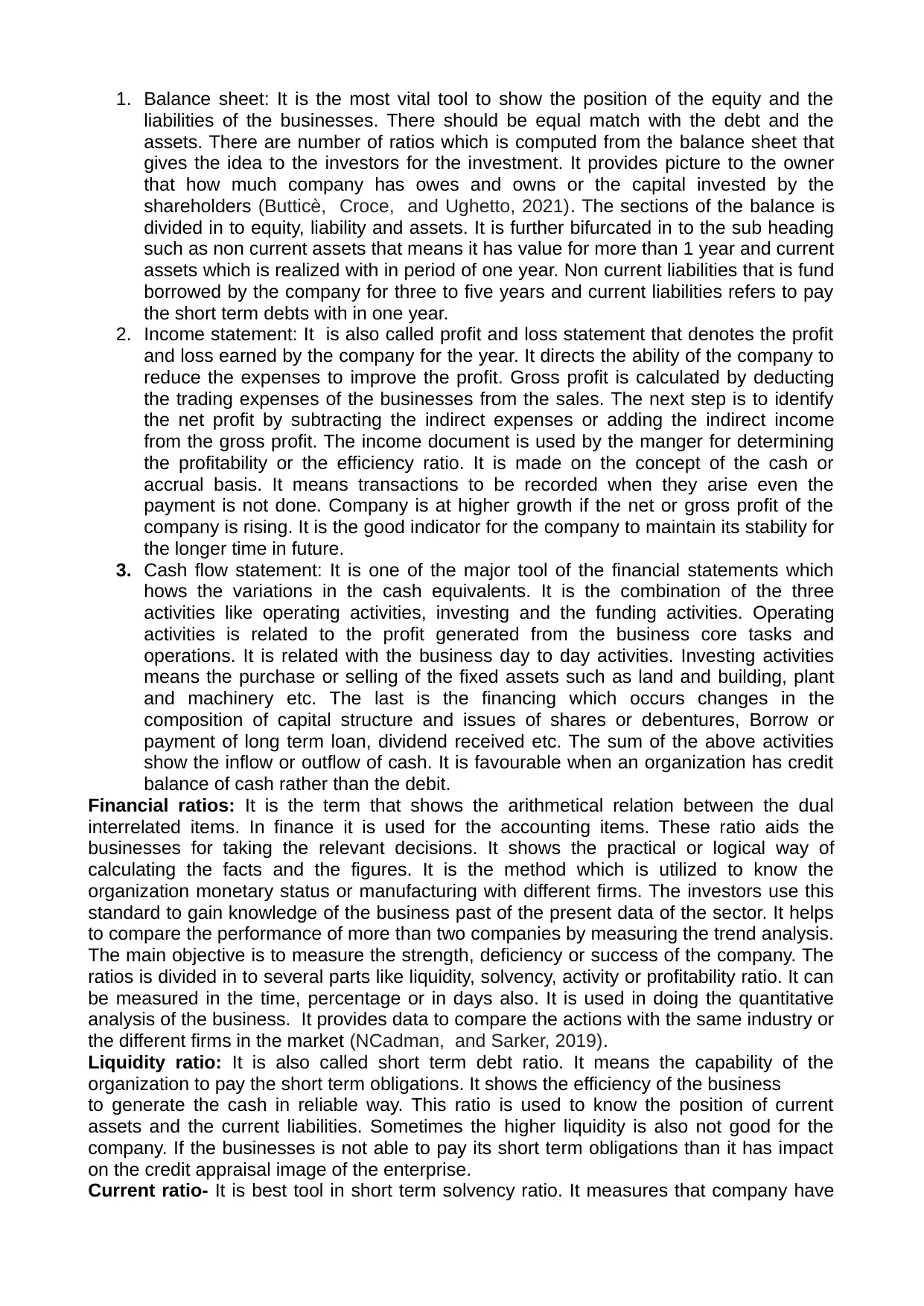
1. Balance sheet: It is the most vital tool to show the position of the equity and the
liabilities of the businesses. There should be equal match with the debt and the
assets. There are number of ratios which is computed from the balance sheet that
gives the idea to the investors for the investment. It provides picture to the owner
that how much company has owes and owns or the capital invested by the
shareholders (Butticè, Croce, and Ughetto, 2021). The sections of the balance is
divided in to equity, liability and assets. It is further bifurcated in to the sub heading
such as non current assets that means it has value for more than 1 year and current
assets which is realized with in period of one year. Non current liabilities that is fund
borrowed by the company for three to five years and current liabilities refers to pay
the short term debts with in one year.
2. Income statement: It is also called profit and loss statement that denotes the profit
and loss earned by the company for the year. It directs the ability of the company to
reduce the expenses to improve the profit. Gross profit is calculated by deducting
the trading expenses of the businesses from the sales. The next step is to identify
the net profit by subtracting the indirect expenses or adding the indirect income
from the gross profit. The income document is used by the manger for determining
the profitability or the efficiency ratio. It is made on the concept of the cash or
accrual basis. It means transactions to be recorded when they arise even the
payment is not done. Company is at higher growth if the net or gross profit of the
company is rising. It is the good indicator for the company to maintain its stability for
the longer time in future.
3. Cash flow statement: It is one of the major tool of the financial statements which
hows the variations in the cash equivalents. It is the combination of the three
activities like operating activities, investing and the funding activities. Operating
activities is related to the profit generated from the business core tasks and
operations. It is related with the business day to day activities. Investing activities
means the purchase or selling of the fixed assets such as land and building, plant
and machinery etc. The last is the financing which occurs changes in the
composition of capital structure and issues of shares or debentures, Borrow or
payment of long term loan, dividend received etc. The sum of the above activities
show the inflow or outflow of cash. It is favourable when an organization has credit
balance of cash rather than the debit.
Financial ratios: It is the term that shows the arithmetical relation between the dual
interrelated items. In finance it is used for the accounting items. These ratio aids the
businesses for taking the relevant decisions. It shows the practical or logical way of
calculating the facts and the figures. It is the method which is utilized to know the
organization monetary status or manufacturing with different firms. The investors use this
standard to gain knowledge of the business past of the present data of the sector. It helps
to compare the performance of more than two companies by measuring the trend analysis.
The main objective is to measure the strength, deficiency or success of the company. The
ratios is divided in to several parts like liquidity, solvency, activity or profitability ratio. It can
be measured in the time, percentage or in days also. It is used in doing the quantitative
analysis of the business. It provides data to compare the actions with the same industry or
the different firms in the market (NCadman, and Sarker, 2019).
Liquidity ratio: It is also called short term debt ratio. It means the capability of the
organization to pay the short term obligations. It shows the efficiency of the business
to generate the cash in reliable way. This ratio is used to know the position of current
assets and the current liabilities. Sometimes the higher liquidity is also not good for the
company. If the businesses is not able to pay its short term obligations than it has impact
on the credit appraisal image of the enterprise.
Current ratio- It is best tool in short term solvency ratio. It measures that company have
liabilities of the businesses. There should be equal match with the debt and the
assets. There are number of ratios which is computed from the balance sheet that
gives the idea to the investors for the investment. It provides picture to the owner
that how much company has owes and owns or the capital invested by the
shareholders (Butticè, Croce, and Ughetto, 2021). The sections of the balance is
divided in to equity, liability and assets. It is further bifurcated in to the sub heading
such as non current assets that means it has value for more than 1 year and current
assets which is realized with in period of one year. Non current liabilities that is fund
borrowed by the company for three to five years and current liabilities refers to pay
the short term debts with in one year.
2. Income statement: It is also called profit and loss statement that denotes the profit
and loss earned by the company for the year. It directs the ability of the company to
reduce the expenses to improve the profit. Gross profit is calculated by deducting
the trading expenses of the businesses from the sales. The next step is to identify
the net profit by subtracting the indirect expenses or adding the indirect income
from the gross profit. The income document is used by the manger for determining
the profitability or the efficiency ratio. It is made on the concept of the cash or
accrual basis. It means transactions to be recorded when they arise even the
payment is not done. Company is at higher growth if the net or gross profit of the
company is rising. It is the good indicator for the company to maintain its stability for
the longer time in future.
3. Cash flow statement: It is one of the major tool of the financial statements which
hows the variations in the cash equivalents. It is the combination of the three
activities like operating activities, investing and the funding activities. Operating
activities is related to the profit generated from the business core tasks and
operations. It is related with the business day to day activities. Investing activities
means the purchase or selling of the fixed assets such as land and building, plant
and machinery etc. The last is the financing which occurs changes in the
composition of capital structure and issues of shares or debentures, Borrow or
payment of long term loan, dividend received etc. The sum of the above activities
show the inflow or outflow of cash. It is favourable when an organization has credit
balance of cash rather than the debit.
Financial ratios: It is the term that shows the arithmetical relation between the dual
interrelated items. In finance it is used for the accounting items. These ratio aids the
businesses for taking the relevant decisions. It shows the practical or logical way of
calculating the facts and the figures. It is the method which is utilized to know the
organization monetary status or manufacturing with different firms. The investors use this
standard to gain knowledge of the business past of the present data of the sector. It helps
to compare the performance of more than two companies by measuring the trend analysis.
The main objective is to measure the strength, deficiency or success of the company. The
ratios is divided in to several parts like liquidity, solvency, activity or profitability ratio. It can
be measured in the time, percentage or in days also. It is used in doing the quantitative
analysis of the business. It provides data to compare the actions with the same industry or
the different firms in the market (NCadman, and Sarker, 2019).
Liquidity ratio: It is also called short term debt ratio. It means the capability of the
organization to pay the short term obligations. It shows the efficiency of the business
to generate the cash in reliable way. This ratio is used to know the position of current
assets and the current liabilities. Sometimes the higher liquidity is also not good for the
company. If the businesses is not able to pay its short term obligations than it has impact
on the credit appraisal image of the enterprise.
Current ratio- It is best tool in short term solvency ratio. It measures that company have
Paraphrase This Document
Need a fresh take? Get an instant paraphrase of this document with our AI Paraphraser
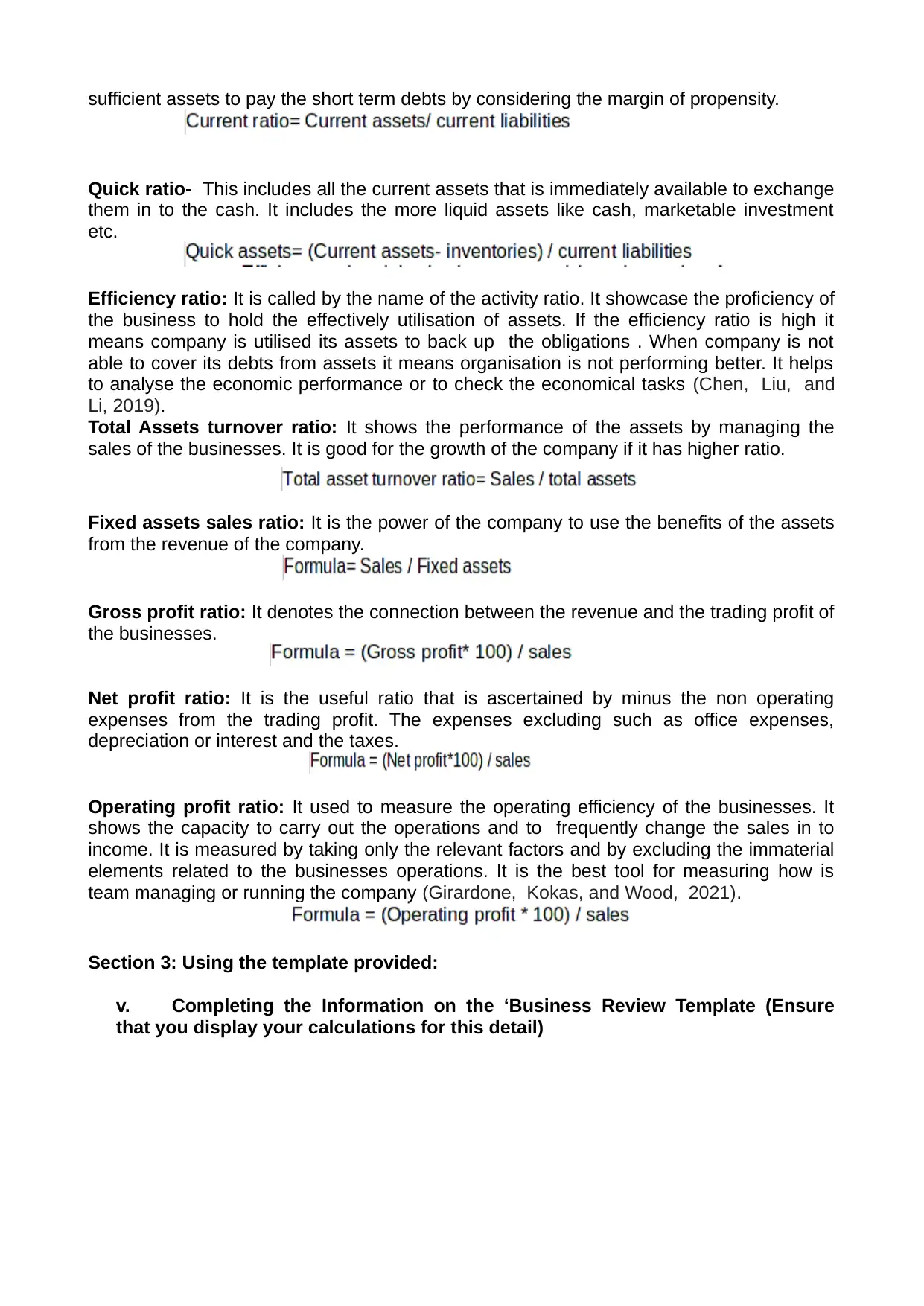
sufficient assets to pay the short term debts by considering the margin of propensity.
Quick ratio- This includes all the current assets that is immediately available to exchange
them in to the cash. It includes the more liquid assets like cash, marketable investment
etc.
Efficiency ratio: It is called by the name of the activity ratio. It showcase the proficiency of
the business to hold the effectively utilisation of assets. If the efficiency ratio is high it
means company is utilised its assets to back up the obligations . When company is not
able to cover its debts from assets it means organisation is not performing better. It helps
to analyse the economic performance or to check the economical tasks (Chen, Liu, and
Li, 2019).
Total Assets turnover ratio: It shows the performance of the assets by managing the
sales of the businesses. It is good for the growth of the company if it has higher ratio.
Fixed assets sales ratio: It is the power of the company to use the benefits of the assets
from the revenue of the company.
Gross profit ratio: It denotes the connection between the revenue and the trading profit of
the businesses.
Net profit ratio: It is the useful ratio that is ascertained by minus the non operating
expenses from the trading profit. The expenses excluding such as office expenses,
depreciation or interest and the taxes.
Operating profit ratio: It used to measure the operating efficiency of the businesses. It
shows the capacity to carry out the operations and to frequently change the sales in to
income. It is measured by taking only the relevant factors and by excluding the immaterial
elements related to the businesses operations. It is the best tool for measuring how is
team managing or running the company (Girardone, Kokas, and Wood, 2021).
Section 3: Using the template provided:
v. Completing the Information on the ‘Business Review Template (Ensure
that you display your calculations for this detail)
Quick ratio- This includes all the current assets that is immediately available to exchange
them in to the cash. It includes the more liquid assets like cash, marketable investment
etc.
Efficiency ratio: It is called by the name of the activity ratio. It showcase the proficiency of
the business to hold the effectively utilisation of assets. If the efficiency ratio is high it
means company is utilised its assets to back up the obligations . When company is not
able to cover its debts from assets it means organisation is not performing better. It helps
to analyse the economic performance or to check the economical tasks (Chen, Liu, and
Li, 2019).
Total Assets turnover ratio: It shows the performance of the assets by managing the
sales of the businesses. It is good for the growth of the company if it has higher ratio.
Fixed assets sales ratio: It is the power of the company to use the benefits of the assets
from the revenue of the company.
Gross profit ratio: It denotes the connection between the revenue and the trading profit of
the businesses.
Net profit ratio: It is the useful ratio that is ascertained by minus the non operating
expenses from the trading profit. The expenses excluding such as office expenses,
depreciation or interest and the taxes.
Operating profit ratio: It used to measure the operating efficiency of the businesses. It
shows the capacity to carry out the operations and to frequently change the sales in to
income. It is measured by taking only the relevant factors and by excluding the immaterial
elements related to the businesses operations. It is the best tool for measuring how is
team managing or running the company (Girardone, Kokas, and Wood, 2021).
Section 3: Using the template provided:
v. Completing the Information on the ‘Business Review Template (Ensure
that you display your calculations for this detail)
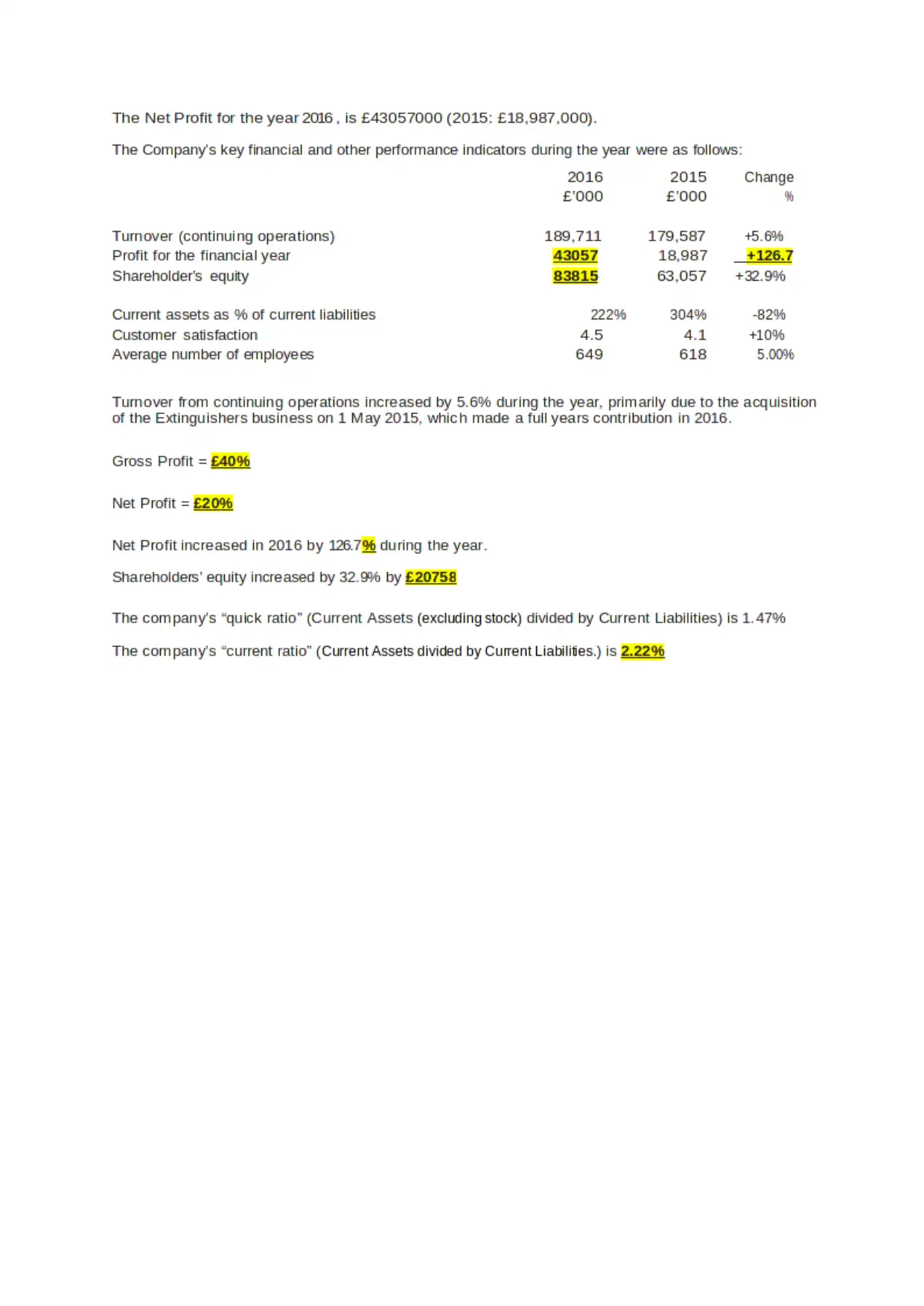
⊘ This is a preview!⊘
Do you want full access?
Subscribe today to unlock all pages.

Trusted by 1+ million students worldwide
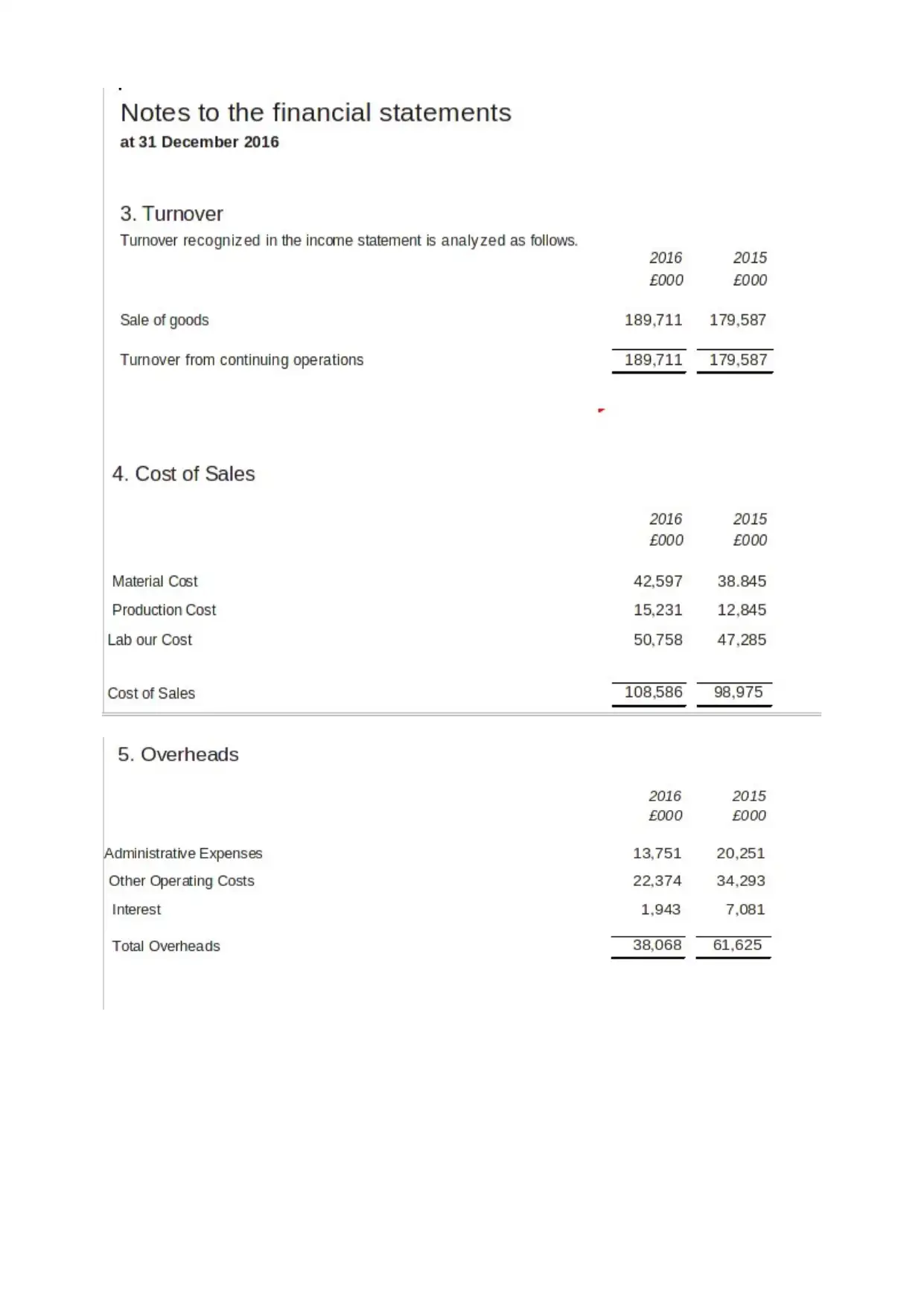
Paraphrase This Document
Need a fresh take? Get an instant paraphrase of this document with our AI Paraphraser
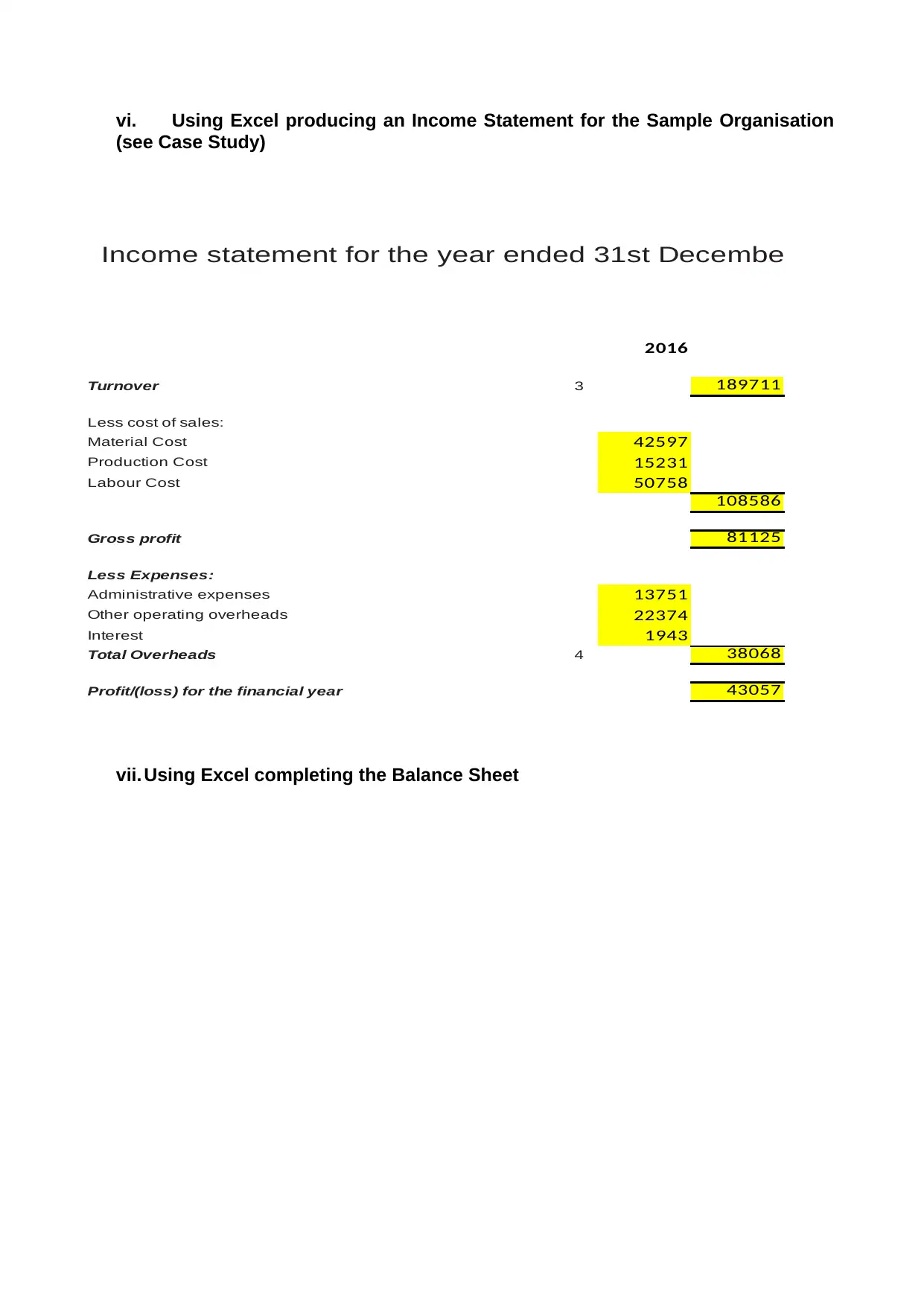
vi. Using Excel producing an Income Statement for the Sample Organisation
(see Case Study)
vii. Using Excel completing the Balance Sheet
Income statement for the year ended 31st December 2016
2016
Turnover 3 189711
Less cost of sales:
Material Cost 42597
Production Cost 15231
Labour Cost 50758
108586
Gross profit 81125
Less Expenses:
Administrative expenses 13751
Other operating overheads 22374
Interest 1943
Total Overheads 4 38068
Profit/(loss) for the financial year 43057
(see Case Study)
vii. Using Excel completing the Balance Sheet
Income statement for the year ended 31st December 2016
2016
Turnover 3 189711
Less cost of sales:
Material Cost 42597
Production Cost 15231
Labour Cost 50758
108586
Gross profit 81125
Less Expenses:
Administrative expenses 13751
Other operating overheads 22374
Interest 1943
Total Overheads 4 38068
Profit/(loss) for the financial year 43057
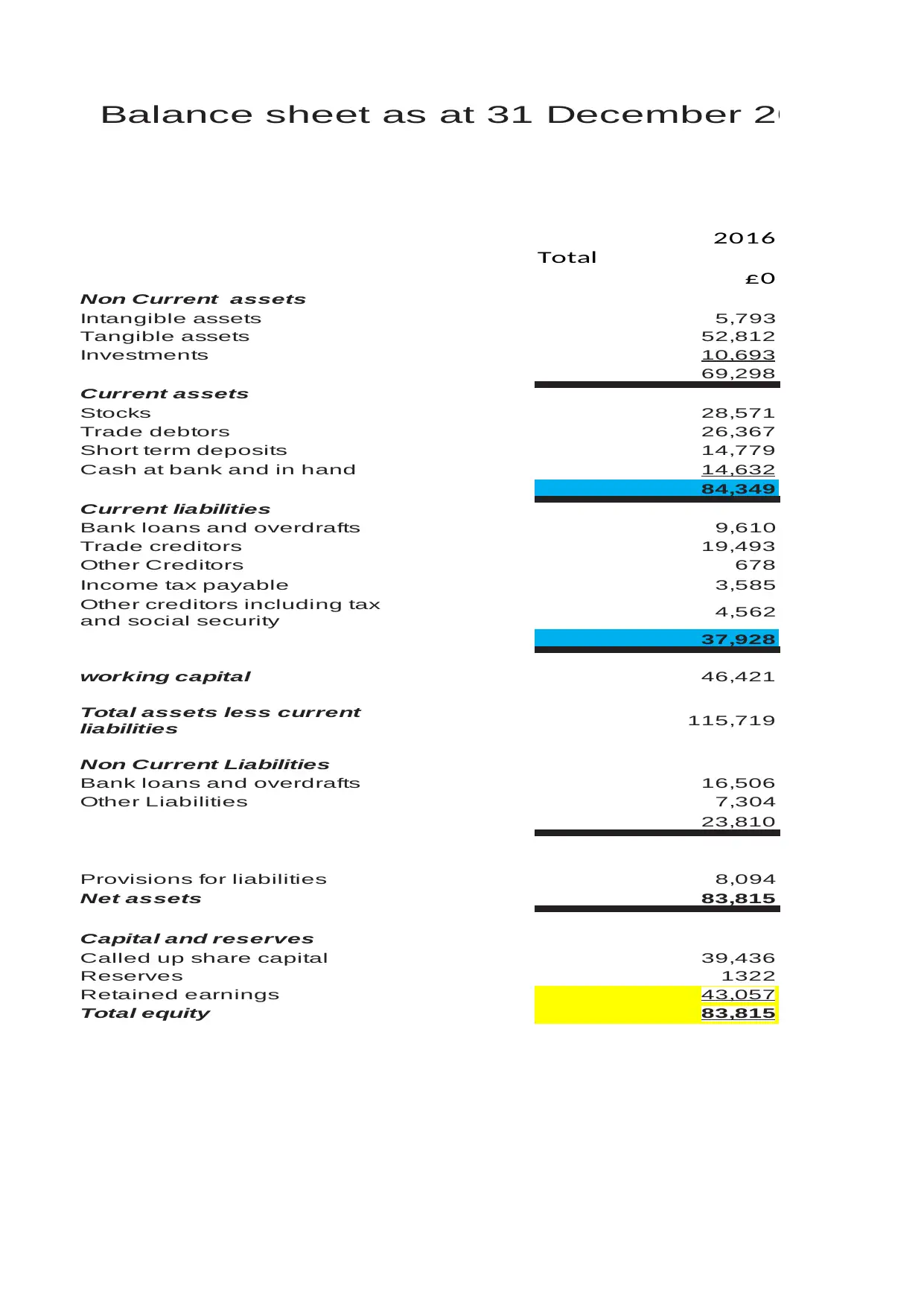
Balance sheet as at 31 December 2016
2016
Total
£0
Non Current assets
Intangible assets 5,793
Tangible assets 52,812
Investments 10,693
69,298
Current assets
Stocks 28,571
Trade debtors 26,367
Short term deposits 14,779
Cash at bank and in hand 14,632
84,349
Current liabilities
Bank loans and overdrafts 9,610
Trade creditors 19,493
Other Creditors 678
Income tax payable 3,585
4,562
37,928
working capital 46,421
115,719
Non Current Liabilities
Bank loans and overdrafts 16,506
Other Liabilities 7,304
23,810
Provisions for liabilities 8,094
Net assets 83,815
Capital and reserves
Called up share capital 39,436
Reserves 1322
Retained earnings 43,057
Total equity 83,815
Other creditors including tax
and social security
Total assets less current
liabilities
2016
Total
£0
Non Current assets
Intangible assets 5,793
Tangible assets 52,812
Investments 10,693
69,298
Current assets
Stocks 28,571
Trade debtors 26,367
Short term deposits 14,779
Cash at bank and in hand 14,632
84,349
Current liabilities
Bank loans and overdrafts 9,610
Trade creditors 19,493
Other Creditors 678
Income tax payable 3,585
4,562
37,928
working capital 46,421
115,719
Non Current Liabilities
Bank loans and overdrafts 16,506
Other Liabilities 7,304
23,810
Provisions for liabilities 8,094
Net assets 83,815
Capital and reserves
Called up share capital 39,436
Reserves 1322
Retained earnings 43,057
Total equity 83,815
Other creditors including tax
and social security
Total assets less current
liabilities
⊘ This is a preview!⊘
Do you want full access?
Subscribe today to unlock all pages.

Trusted by 1+ million students worldwide
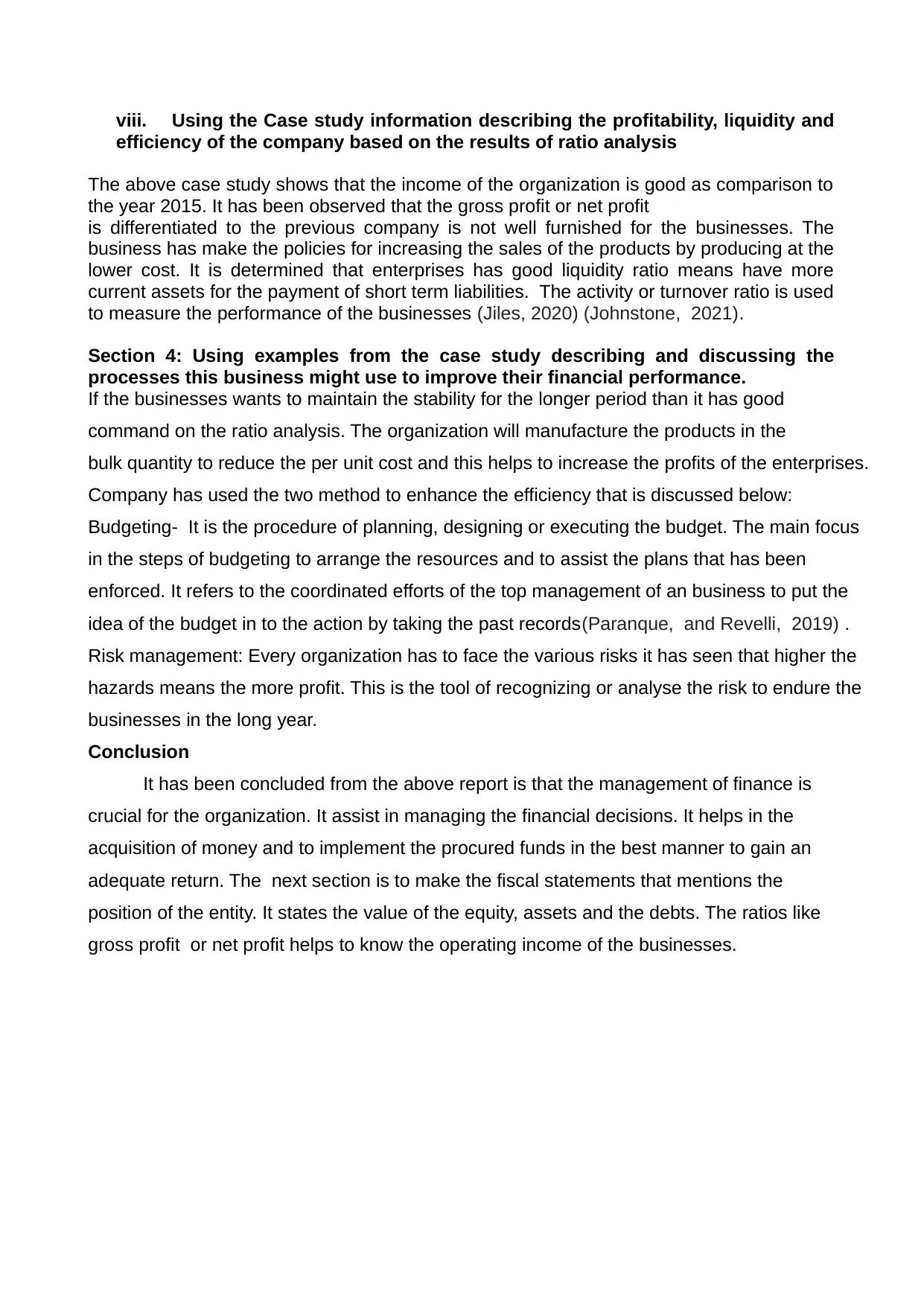
viii. Using the Case study information describing the profitability, liquidity and
efficiency of the company based on the results of ratio analysis
The above case study shows that the income of the organization is good as comparison to
the year 2015. It has been observed that the gross profit or net profit
is differentiated to the previous company is not well furnished for the businesses. The
business has make the policies for increasing the sales of the products by producing at the
lower cost. It is determined that enterprises has good liquidity ratio means have more
current assets for the payment of short term liabilities. The activity or turnover ratio is used
to measure the performance of the businesses (Jiles, 2020) (Johnstone, 2021).
Section 4: Using examples from the case study describing and discussing the
processes this business might use to improve their financial performance.
If the businesses wants to maintain the stability for the longer period than it has good
command on the ratio analysis. The organization will manufacture the products in the
bulk quantity to reduce the per unit cost and this helps to increase the profits of the enterprises.
Company has used the two method to enhance the efficiency that is discussed below:
Budgeting- It is the procedure of planning, designing or executing the budget. The main focus
in the steps of budgeting to arrange the resources and to assist the plans that has been
enforced. It refers to the coordinated efforts of the top management of an business to put the
idea of the budget in to the action by taking the past records(Paranque, and Revelli, 2019) .
Risk management: Every organization has to face the various risks it has seen that higher the
hazards means the more profit. This is the tool of recognizing or analyse the risk to endure the
businesses in the long year.
Conclusion
It has been concluded from the above report is that the management of finance is
crucial for the organization. It assist in managing the financial decisions. It helps in the
acquisition of money and to implement the procured funds in the best manner to gain an
adequate return. The next section is to make the fiscal statements that mentions the
position of the entity. It states the value of the equity, assets and the debts. The ratios like
gross profit or net profit helps to know the operating income of the businesses.
efficiency of the company based on the results of ratio analysis
The above case study shows that the income of the organization is good as comparison to
the year 2015. It has been observed that the gross profit or net profit
is differentiated to the previous company is not well furnished for the businesses. The
business has make the policies for increasing the sales of the products by producing at the
lower cost. It is determined that enterprises has good liquidity ratio means have more
current assets for the payment of short term liabilities. The activity or turnover ratio is used
to measure the performance of the businesses (Jiles, 2020) (Johnstone, 2021).
Section 4: Using examples from the case study describing and discussing the
processes this business might use to improve their financial performance.
If the businesses wants to maintain the stability for the longer period than it has good
command on the ratio analysis. The organization will manufacture the products in the
bulk quantity to reduce the per unit cost and this helps to increase the profits of the enterprises.
Company has used the two method to enhance the efficiency that is discussed below:
Budgeting- It is the procedure of planning, designing or executing the budget. The main focus
in the steps of budgeting to arrange the resources and to assist the plans that has been
enforced. It refers to the coordinated efforts of the top management of an business to put the
idea of the budget in to the action by taking the past records(Paranque, and Revelli, 2019) .
Risk management: Every organization has to face the various risks it has seen that higher the
hazards means the more profit. This is the tool of recognizing or analyse the risk to endure the
businesses in the long year.
Conclusion
It has been concluded from the above report is that the management of finance is
crucial for the organization. It assist in managing the financial decisions. It helps in the
acquisition of money and to implement the procured funds in the best manner to gain an
adequate return. The next section is to make the fiscal statements that mentions the
position of the entity. It states the value of the equity, assets and the debts. The ratios like
gross profit or net profit helps to know the operating income of the businesses.
Paraphrase This Document
Need a fresh take? Get an instant paraphrase of this document with our AI Paraphraser
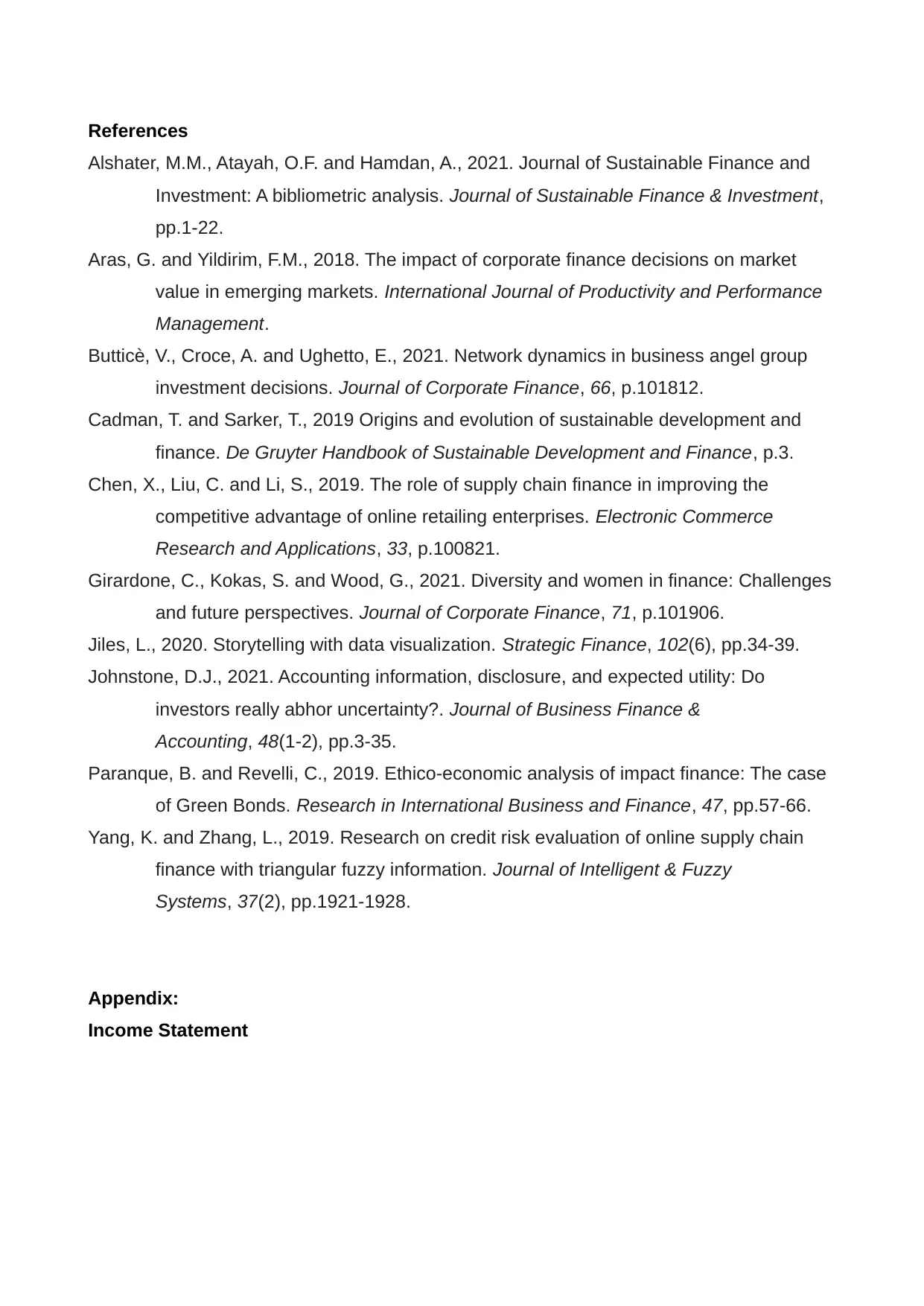
References
Alshater, M.M., Atayah, O.F. and Hamdan, A., 2021. Journal of Sustainable Finance and
Investment: A bibliometric analysis. Journal of Sustainable Finance & Investment,
pp.1-22.
Aras, G. and Yildirim, F.M., 2018. The impact of corporate finance decisions on market
value in emerging markets. International Journal of Productivity and Performance
Management.
Butticè, V., Croce, A. and Ughetto, E., 2021. Network dynamics in business angel group
investment decisions. Journal of Corporate Finance, 66, p.101812.
Cadman, T. and Sarker, T., 2019 Origins and evolution of sustainable development and
finance. De Gruyter Handbook of Sustainable Development and Finance, p.3.
Chen, X., Liu, C. and Li, S., 2019. The role of supply chain finance in improving the
competitive advantage of online retailing enterprises. Electronic Commerce
Research and Applications, 33, p.100821.
Girardone, C., Kokas, S. and Wood, G., 2021. Diversity and women in finance: Challenges
and future perspectives. Journal of Corporate Finance, 71, p.101906.
Jiles, L., 2020. Storytelling with data visualization. Strategic Finance, 102(6), pp.34-39.
Johnstone, D.J., 2021. Accounting information, disclosure, and expected utility: Do
investors really abhor uncertainty?. Journal of Business Finance &
Accounting, 48(1-2), pp.3-35.
Paranque, B. and Revelli, C., 2019. Ethico-economic analysis of impact finance: The case
of Green Bonds. Research in International Business and Finance, 47, pp.57-66.
Yang, K. and Zhang, L., 2019. Research on credit risk evaluation of online supply chain
finance with triangular fuzzy information. Journal of Intelligent & Fuzzy
Systems, 37(2), pp.1921-1928.
Appendix:
Income Statement
Alshater, M.M., Atayah, O.F. and Hamdan, A., 2021. Journal of Sustainable Finance and
Investment: A bibliometric analysis. Journal of Sustainable Finance & Investment,
pp.1-22.
Aras, G. and Yildirim, F.M., 2018. The impact of corporate finance decisions on market
value in emerging markets. International Journal of Productivity and Performance
Management.
Butticè, V., Croce, A. and Ughetto, E., 2021. Network dynamics in business angel group
investment decisions. Journal of Corporate Finance, 66, p.101812.
Cadman, T. and Sarker, T., 2019 Origins and evolution of sustainable development and
finance. De Gruyter Handbook of Sustainable Development and Finance, p.3.
Chen, X., Liu, C. and Li, S., 2019. The role of supply chain finance in improving the
competitive advantage of online retailing enterprises. Electronic Commerce
Research and Applications, 33, p.100821.
Girardone, C., Kokas, S. and Wood, G., 2021. Diversity and women in finance: Challenges
and future perspectives. Journal of Corporate Finance, 71, p.101906.
Jiles, L., 2020. Storytelling with data visualization. Strategic Finance, 102(6), pp.34-39.
Johnstone, D.J., 2021. Accounting information, disclosure, and expected utility: Do
investors really abhor uncertainty?. Journal of Business Finance &
Accounting, 48(1-2), pp.3-35.
Paranque, B. and Revelli, C., 2019. Ethico-economic analysis of impact finance: The case
of Green Bonds. Research in International Business and Finance, 47, pp.57-66.
Yang, K. and Zhang, L., 2019. Research on credit risk evaluation of online supply chain
finance with triangular fuzzy information. Journal of Intelligent & Fuzzy
Systems, 37(2), pp.1921-1928.
Appendix:
Income Statement

Income statement for the year ended 31st December 2016
2016
Turnover 3 189711
Less cost of sales:
Material Cost 42597
Production Cost 15231
Labour Cost 50758
108586
Gross profit 81125
Less Expenses:
Administrative expenses 13751
Other operating overheads 22374
Interest 1943
Total Overheads 4 38068
Profit/(loss) for the financial year 43057
2016
Turnover 3 189711
Less cost of sales:
Material Cost 42597
Production Cost 15231
Labour Cost 50758
108586
Gross profit 81125
Less Expenses:
Administrative expenses 13751
Other operating overheads 22374
Interest 1943
Total Overheads 4 38068
Profit/(loss) for the financial year 43057
⊘ This is a preview!⊘
Do you want full access?
Subscribe today to unlock all pages.

Trusted by 1+ million students worldwide
1 out of 12
Related Documents
Your All-in-One AI-Powered Toolkit for Academic Success.
+13062052269
info@desklib.com
Available 24*7 on WhatsApp / Email
![[object Object]](/_next/static/media/star-bottom.7253800d.svg)
Unlock your academic potential
Copyright © 2020–2025 A2Z Services. All Rights Reserved. Developed and managed by ZUCOL.

